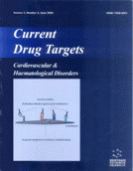Abstract
In patients with acute coronary syndromes, inhibition of platelet aggregation with parenteral αIIb/βIII antagonists has proven effective at preventing nonfatal myocardial infarction and repeat percutaneous coronary interventions. Paradoxically, the efficacy observed for acute indications and parenteral agents has not extended to oral agents and chronic prevention of secondary thrombotic events, despite robust antithrombotic properties in preclinical thrombosis models. This report documents the preclinical data of Lotrafiban, an oral αIIb/βIII antagonist that recently failed in a phase III clinical trial (BRAVO) for the prevention of secondary thrombosis. Lotrafiban was characterized in a dog circumflex artery electrical injury model, and a cyclic flow reduction model (“Folts”). The data demonstrate that both oral (1.0-50.0 mg/kg) and intravenous (0.1-0.8ug/kg/min) administration of lotrafiban produced dose-related inhibition (45%-95%) of ex vivo platelet aggregation. In the electrical injury model, the doserelated inhibition correlated with a significant reduction in the frequency of coronary occlusion, size of the developing thrombus, and the extent of left ventricular ischemic damage. Effects on blood flow and bleeding time were also dose related. The combination of low dose lotrafiban (0.1ug/kg/min) and aspirin (5.0 mg/kg) generated additive antithrombotic effects, approximating the antithrombotic efficacy of a 2-4 fold higher dose of lotrafiban while only modestly prolonging the bleeding time. For purposes of comparison, the ADP receptor antagonist clopidogrel was also assessed in the electrical injury model. Clopidogrel (5.0-10.0 mg/kg, iv.) significantly reduced the resulting left ventricular infarct areas, but lacked the overall efficacy of lotrafiban. In the “Folts” model, lotrafiban inhibited cyclic blood flow reductions (CFRs) by 100% in animals insensitive to the antithrombotic effects of aspirin. Overall, the preclinical data demonstrated that αIIb/βIII antagonism with lotrafiban was a well tolerated and effective strategy for attenuating acute arterial thrombosis. The lack of a correlation between these preclinical data and the outcome of the clinical trial BRAVO are unexplained. However, the combined evidence suggests that these acute canine thrombosis studies may not completely capture the pathology reflected in chronic human atherothrombotic disease.
Keywords: Lotrafiban, Thrombosis Models, Platelet Aggregation, Preclinical, Clinical Thrombosis, Atherothrombotic disease, Clinical Correlations, BRAVO clinical trial, GP IIb/IIIa
 13
13













